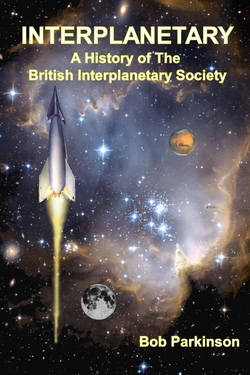Centauri Dreams
Imagining and Planning Interstellar Exploration
Tightening the Beam: Correspondence on PROCSIMA
Yesterday’s post on PROCSIMA (Photon-paRticle Optically Coupled Soliton Interstellar Mission Accelerator) has been drawing a good deal of comment, and I wanted to dig deeper into the concept this morning by presenting some correspondence between plasma physicist Jim Benford, a familiar face on Centauri Dreams, and PROCSIMA’s creator, Chris Limbach (Texas A&M Engineering Experiment Station). As we saw yesterday, PROCSIMA goes to work on the problem of beam spread in both laser and particle beam propulsion concepts.
In my own email exchange with Dr. Limbach, he took note of the comments to yesterday’s Centauri Dreams article, with a useful nod to a concept called ‘optical tweezers’ that may be helpful. So let me start with his message of April 4, excerpting directly from the text:
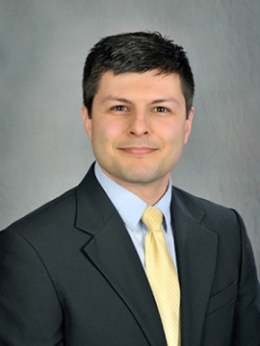
I took a quick glance at the comments, and I see that the laser guiding (i.e. waveguide) effect is fairly well understood, but the guiding of the particles is less clear. I admit this is the less intuitive aspect and the weak interaction requires special consideration in the combined beam design. But to give a general sense, we are taking advantage of the same effect as optical tweezers (https://en.wikipedia.org/wiki/Optical_tweezers) except applied on the level of atoms instead of nanoparticles. That is, the atoms in our neutral beam are drawn to the high intensity region because they can be polarized.
I hope your readers are as excited about this project as I am!
Personally, I do find the project exciting because I’ve been writing about the problems of keeping a laser beam collimated for an interstellar mission ever since I began digging into Robert Forward’s papers back around the turn of this century. You may remember the vast Fresnel lens that Forward proposed in the outer Solar System as a way of collimating the laser beam for interstellar use. Avoiding such colossal feats of engineering would be a welcome outcome!
We’ve examined the pros and cons of particle beams in these pages as well, learning that there is controversy over the question of whether neutral particle beams would not likewise be subject to beam spread. Geoff Landis has argued that “…beam spread due to diffraction is not a problem,” while Jim Benford has offered a strong disagreement. See yesterday’s post, as well as Beaming to a Magnetic Sail.
The PROCSIMA idea combines a neutral particle beam and a laser beam to eliminate beam spread and diffraction in both. If it can be made to work, it seems to offer long periods of acceleration for beamed interstellar sails and high delta-V. An Alpha Centauri mission with a flight time of about 40 years becomes possible with a spacecraft reaching 10 percent of the speed of light. Dr. Limbach had been discussing the idea with plasma physicist Benford before the NIAC Phase I award was granted, and they engaged in further correspondence about the idea shortly after.
Here is an excerpt of a Benford message from last August with regard to PROCSIMA. The paper he refers to is a fleshed out and much more detailed version of Jim’s Sails Driven by Diverging Neutral Particle Beams, which ran in these pages in 2014. It has been accepted at the Journal of the British Interplanetary Society, where publication is expected this fall:
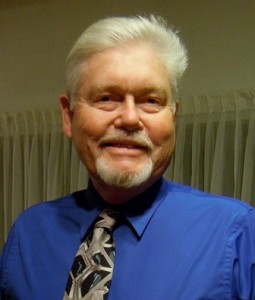
Chris: I made more revisions on my paper than I had expected, and submitted it to JBIS last night. It is attached.
On your laser tweezers idea, I assume the wavelength of the laser will be much much larger than the size of the atoms. So you will treat their interaction as electric dipoles in the electric field of the laser. What intensities of laser would you need in order to defeat the divergence of such a beam? The beams themselves will probably be on the order of 10 cm-1 m in diameter and so the laser beam will be of comparable size, I suppose.
Of course, the introduction of a powerful laser adds a complexity to the overall system, but the remarkable focus that you are expecting would be very interesting to see.
I will keep your idea to myself, but I’m sure that the community, in particular Gerry Nordley, Adam Crowl and Geoff Landis, would be very interested to hear about it.
By the way, there is at a meeting that’s entirely relevant to this, in October in Huntsville Alabama. It’s the Tennessee Valley Interstellar Workshop, which expects to have about 200 people attending. I attach their newsletter. Unfortunately, they don’t do streaming, so one has to attend to hear the talks!
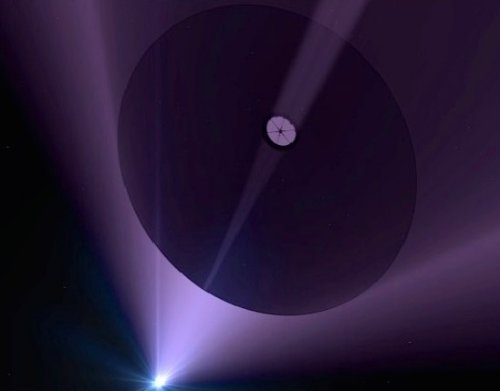
Image: Beamed propulsion leaves propellant behind, a key advantage. Coupled with very small probes, it could provide a path for flyby missions to the nearest stars. PROCSIMA studies the possibility that the problem of beam spread can be resolved. Credit: Adrian Mann.
Chris Limbach was unable to attend the TVIW meeting, but he replied to Benford in a message on August 15:
Thank you for your quick reply. My timing was fortuitous! Also, thank you for offering to send an updated version of your forthcoming paper.
I would like to hold this concept closely until I submit the full proposal, but I will describe the general outline. I only ask that you do not share with anyone in the near-term.
Essentially, I have discovered that a neutral particle beam and high intensity laser beam can be combined in such a way as to simultaneously eliminate the problems of diffraction and beam divergence. This is possible because of physical mechanisms that 1) attract atoms into regions of high optical intensity (i.e. toward the center of the laser beam) and 2) provide an optical focusing effect in regions of high atom density (i.e. toward the center of the neutral beam). If these two effects can be balanced then both the neutral beam and laser beam will propagate, together, without any divergence. After running the numbers, I believe a spot size of 5 meters could be maintained over several astronomical units (!).
I am still concerned that higher-order effects will cause problems, but I believe the basic numbers work out and the concept warrants further investigation/optimization. I am interested in your paper because the neutral beam divergence will place fundamental constraints on certain parameters (e.g. particle density, laser beam intensity, …) for this concept.
After the August messages, the correspondence ended until news of the recent NIAC funding, about which Dr. Limbach informed Jim Benford, leading to my own conversation with Jim and agreement with both scientists that this correspondence could be reproduced to help clarify aspects of the PROCSIMA project. As I mentioned yesterday, there are two levels of funding at NIAC, with PROCSIMA currently receiving Phase I funding. After Phase I’s initial definition and analysis, a Phase II grant can be applied for to develop the concept further.
We’ll await the completion of the Phase I study with great interest, given that a successful PROCSIMA would deliver the best of both the laser and neutral particle beam ideas, while removing one of their biggest problems. If it works, this idea should be readily scalable, pointing to its uses in fast missions throughout the Solar System and interstellar precursors far beyond the heliosphere. The idea has to be shaken out through this initial NIAC work, but it is certainly gaining the attention of the beamed propulsion community.

PROCSIMA: Wedding Two Beam Concepts
The name Proxima will always have resonance with interstellar theorists given that our nearest target — and one with a potentially life-bearing planet at that — is Proxima Centauri. Thus an acronym with the same pronunciation is bound to catch the attention. PROCSIMA stands for Photon-paRticle Optically Coupled Soliton Interstellar Mission Accelerator, one of 25 early-stage technology proposals selected for Phase I funding by the NASA Innovative Advanced Concepts (NIAC) office. A number of Phase II proposals selected for funding was also announced.
These awards are always fascinating to watch because they’re chosen from a host of bleeding edge ideas, helping us keep a finger on the pulse of deep space thinking even if many of them end with their Phase I funding, $125,000 over nine months to produce an initial definition and analysis. Should the results be encouraging, Phase II funding becomes a possibility, ramping the money up to $500,000 over two years to encourage further development.
The 2018 Phase I competition involved over 230 proposals and just 25 winners, a tough selection process that resulted in a number of interesting proposals. NIAC works by fostering ideas from a wide range of scientists working outside NASA’s umbrella, as Jim Reuter, acting associate administrator of NASA’s Space Technology Mission Directorate, notes:
“The NIAC program gives NASA the opportunity to explore visionary ideas that could transform future NASA missions by creating radically better or entirely new concepts while engaging America’s innovators and entrepreneurs as partners in the journey. The concepts can then be evaluated for potential inclusion into our early stage technology portfolio.”
Creating a Tight Beam
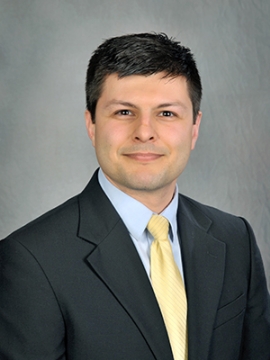
We’ll have plenty to work with over the next few days, but I’ll start with PROCSIMA, which comes from Chris Limbach (Texas A&M Engineering Experiment Station), and points to the possibility of solving a tricky problem in beamed propulsion. Specifically, if you’re using a laser beam to push a sail, how can you reduce the spread of the beam, keeping it collimated so that it will disperse as little as possible with distance? A perfectly collimated beam seems impossible because of diffraction, thus limiting the length of time our sail can remain under acceleration.
Image: Texas A&M’s Christopher Limbach. Credit: Texas A&M.
Particle beams, which actually offer more momentum per unit energy than laser beams, likewise tend to diverge, although as we’ve seen in earlier articles, the nature of the divergence is problematic (see the contrasting views of Jim Benford and Geoff Landis on the matter, as in Beaming to a Magnetic Sail). Particle beams might turn out to be just the ticket for fast in-system transportation as far out as the Oort Cloud, while being limited because of beam spread when it comes to interstellar applications. That makes divergence an issue for both types of beam.
But I should quote Geoff Landis (NASA GRC) first, because he thinks the neutral particle beam problem can be surmounted. Landis works with mercury in his example:
[Thermal beam divergence] could be reduced if the particles in the beam condense to larger particles after acceleration. To reduce the beam spread by a factor of a thousand, the number of mercury atoms per condensed droplet needs to be at least a million. This is an extremely small droplet (10-16 g) by macroscopic terms, and it is not unreasonable to believe that such condensation could take place in the beam. As the droplet size increases, this propulsion concept approaches that of momentum transfer by use of pellet streams, considered for interstellar propulsion by Singer and Nordley.
Benford sees the divergence problem as fundamental. Charged beams would interact, spiraling around each other to produce transverse motion that creates beam divergence. Neutral particle beams would seem to be the ticket if Landis is right, but Benford sees three problems. Let me quote him (from Sails Driven by Diverging Neutral Particle Beams; a JBIS paper on these matters has been accepted for publication but is not yet available):
First, the acceleration process can give the ions a slight transverse motion as well as propelling them forward. Second, focusing magnets bend low-energy ions more than high-energy ions, so slight differences in energy among the accelerated ions lead to divergence (unless compensated by more complicated bending systems).
Third, and quite fundamentally, the divergence angle introduced by stripping electrons from a beam of negative hydrogen or tritium ions to produce a neutral beam gives the atom a sideways motion. (To produce a neutral hydrogen beam, negative hydrogen atoms with an extra electron are accelerated; the extra electron is removed as the beam emerges from the accelerator.)
Reducing the first two causes of beam divergence, Benford believes, is theoretically possible, but he sees the last source of divergence as unavoidable, nor does he accept Gerald Nordley’s idea of reducing neutral particle beam divergence through laser cooling. And he finds Geoff Landis’ idea of having neutral atoms in the particle beam condense (see Landis citation below) to be unlikely to succeed. Are our beaming strategies hopelessly compromised by all this?
PROCSIMA tries to get around the problem by combining a neutral particle beam and a laser beam, a technique that, according to Chris Limbach, could prevent spread and diffraction in both kinds of beam. Let me quote him from the NIAC description:
The elimination of both diffraction and thermal spreading is achieved by tailoring the mutual interaction of the laser and particle beams so that (1) refractive index variations produced by the particle beam generate a waveguide effect (thereby eliminating laser diffraction) and (2) the particle beam is trapped in regions of high electric field strength near the center of the laser beam. By exploiting these phenomena simultaneously, we can produce a combined beam that propagates with a constant spatial profile, also known as a soliton.
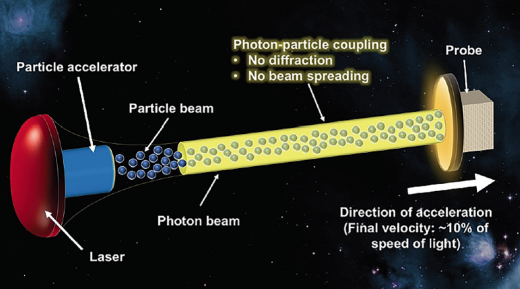
Image: Graphic depiction of PROCSIMA: Diffractionless Beamed Propulsion for Breakthrough Interstellar Missions. Credit: C. Limbach.
An interesting concept because it draws from recent work in high-energy lasers as well as high-energy neutral particle beams, producing a hybrid notion that seems worth exploring. In his precis on PROCSIMA, Limbach says he believes this beamed propulsion architecture would increase the probe acceleration distance by a factor of ~10,000, allowing us to send a 1 kg payload to Proxima Centauri at 10 percent of lightspeed, making for a 42-year mission.
We watch laser developments with interest particularly with regard to Breakthrough Starshot, which assumes a similar high-energy laser capability in the 50 GW range. Starshot is an investigation into nano-scale payloads carried by small beamed sails to nearby stars. Can we tap neutral particle beam technology to achieve increased delta-V, solving the diffraction problem at the same time? As Limbach points out, such technologies are a hot topic within the nuclear fusion community, which looks at heating magnetically confined fusion plasmas.
Expect more on this concept in short order. The Landis paper is “Interstellar flight by particle beam,” Acta Astronautica 55 (2004), 931-934. I’ll have a full citation on the Benford paper as soon as it is published.

2001: A Space Odyssey – 50 Years Later
Fifty years ago today, 2001: A Space Odyssey was all the buzz, and I was preparing to see it within days on a spectacular screen at the Loew’s State Theater in St. Louis. The memory of that first viewing will always be bright, but now we have seasoned perspective from Centauri Dreams regular Al Jackson, working with Bob Mahoney and Jon Rogers, to put the film in perspective. The author of numerous scientific papers, Al’s service to the space program included his time on the Lunar Module Simulator for Apollo, described below, and his many years at Johnson Space Center, mostly for Lockheed working the Shuttle and ISS programs. But let me get to Al’s foreword — I’ll introduce Bob Mahoney and Jon Rogers within the text in the caption to their photos. Interest in 2001 is as robust as ever — be aware that a new 513-page book about the film is about to be published. It’s Michael Benson’s Space Odyssey: Stanley Kubrick, Arthur C. Clarke, and the Making of a Masterpiece. Let’s now return to the magic of Kubrick’s great film.
By Al Jackson, Bob Mahoney and Jon Rogers
Foreword
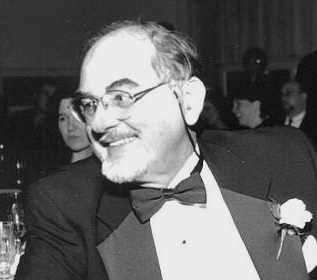
By the 1st of April, 1968 I had been working in the Apollo program as an astronaut trainer for the Lunar Mission Simulator, LMS, for 2 and a half years. I had also been a science fiction fan for 15 years at that time, so I had kept up with, as best as one could, Stanley Kubrick’s production of 2001: A Space Odyssey. The film premiered in Washington, DC on April 2, 1968 (it had an earlier test showing in New York). I think it premiered in Houston on a Friday, April 5 (a day after the Martin Luther King assassination). Boy! I sure tried to wangle a ticket for that but could not. However I did see the film on April 6, at the Windsor Theater in Houston on a gorgeous 70mm Cinerama screen. It was a stunning film since I had been nuts about space flight since I was 10 years old. A transcendental moment! A few things:
(1) Having read everything Arthur C. Clarke had written, I grasped essence of the story the first time through. I saw the film six more times at the Windsor in 1968, and once in March of 1969 on another big screen in Houston. That was the last time I have seen it in true 70mm. All was confirmed when I read Clarke’s novel a few weeks later.
(2) On Monday morning, the 8th of April, 1968 Neil Armstrong and Buzz Aldrin were scheduled in the LMS for training. I remember James Lovell, Bill Anders and Fred Haise standing around the coffee pot talking to Buzz. He surprised me by holding forth on how 2001’s narrative seemed to him a rework of ideas by Clarke in Childhood’s End, as well as Clarke’s thoughts in essays. In all the time he spent in the simulator, I don’t think we ever talked science fiction.
(3) Having been ’embedded’ in space flight first as a ‘space cadet’ and then plunged, as a NASA civil servant, into the whirlwind that was Apollo, I had a jaundiced eye for manned space flight. I was thrilled to see a nuclear powered exploration spacecraft, a monstrous space station and a huge base on the Moon, all technically realizable in 30 or so years. But I was getting pretty seasoned on the realities of manned spaceflight, so a little voice in the back of my brain said No Way, No How is that going to be there in 30 years. It all passed into an alternate universe in 2001. Yet I didn’t imagine that no manned flight would go out of low Earth orbit in 50 years!
Half a Century of 2001
April of 2018 marks the fiftieth anniversary of the release of Stanley Kubrick and Arthur C. Clarke’s science fiction film 2001: A Space Odyssey and the novel of the same name. The narrative structure of the film is a transcendent philosophical meditation on extraterrestrial civilizations and biological evolution, a theme known in science fiction prose from H.G. Wells to the present as BIG THINKS. Books, articles, and even doctoral dissertations have been written about the film. Framing these deeper speculations was a ‘future history’ constructed on a foundation of rigorously researched, then-current scientific and engineering knowledge. We address this technology backdrop and assess its accuracy. We’ll leave any commentary on the film’s philosophy to film critics and buffs.
Hailed at the time as a bold vision of our future in space, it presented both Kubrick’s and. Clarke’s predictions of spaceflight three decades beyond the then-current events of the Gemini and early Apollo programs. One’s impression now is that Kubrick and Clarke were overly optimistic. We certainly don’t have 1000-foot diameter space stations (the one shown in the film was SS Five; we never see the other four) spinning in Earth orbit and multiple large bases on the lunar surface supporting hundreds of people. And the Galileo and Cassini probes were a far cry from nuclear-powered manned missions to the outer planets.
But those extrapolations are programmatic in nature, not technology-related. One must recall that the film was conceived in early 1965, when the space programs of both the U.S. and U.S.S.R. were racing ahead at full speed. Prose science fiction of the late 1930’s through 1965 is an indicator that many writers assumed extensive spaceflight exploits were perfectly feasible (even inevitable) by the turn of the last century. (It should be noted that many prose science fiction writers such as Robert Heinlein, Isaac Asimov and Arthur C. Clarke, and many others, hedged their bets and put the technological developments depicted in the film more than 100 years beyond 2001.) The many social ,economic and political circumstances that would place pressures on space program funding were not fully understood at the film’s production. This was also at a time when individual countries unilaterally pursued their own space programs.
Yet when one looks beyond the obvious programmatic “overshoot” of the film to the technical and operational details of their portrayal of spaceflight, Kubrick and Clarke’s cinematic glance into the crystal ball seems much more remarkable. There are few sources of technical material about the spacecraft in the film although we know that Marshall engineers Frederick Ordway and Harry Lange (7,8), spent nearly three years designing the technical details for the film with the help of both the American and British aerospace industries. Their considerable efforts are evident even down to the details.

Image: Discovery in Jupiter space. Credit: Jon Rogers.
Space Transport to Earth Orbit
Take the Orion III space plane. Excluding the Pan Am logo (no one would have expected Pan Am to go bankrupt only 15 years later!), the space plane ferrying Dr. Floyd into Earth orbit shares an amazing number of features with the once active space plane, the Space Shuttle. Not only does it have a double-delta wing, but the three sweep angles (both leading and trailing edges) are within 10 degrees of those on NASA’s shuttle. One also finds it intriguing (as superficial a matter as this might be) that the back ends of both vehicles have double bulges to accommodate their propulsion systems.
Watching the docking sequence cockpit view in the film is like sitting in the flight engineer’s seat on a shuttle’s flight deck. Three primary computer screens, data meters spanning the panel over the windshield, a computer system by IBM, dynamic graphics of the docking profile can be found in the Orbiters. The real Shuttle approaches not nose-first but top-first, and the dynamic images of space station approaches are displayed on laptop computers, not the primary computer screens. The laptop imagery in the Shuttles was due to the evolution in computer technology, which did not exist when the 2001 space planes were conceived.
Another implied technical feature of the Orion III docking operation is that the space plane’s crew is not doing the flying; the space plane’s computers are. While this isn’t quite the way the Shuttle docked to the space station today (the crews flew most of the approach and docking manually but their stick and engine-firing commands pass through the computers), fully automatic dockings have been the norm for Russian Soyuz and Progress for many years and for the ESA Automated Transfer Vehicle. The premise of the space plane flying itself as the crew monitors its progress was standard operating procedure for Shuttle ascents and entry.
Speaking of ascent, the film leaves us to speculate on how the Orion III achieved orbit. The book 2001: A Space Odyssey [1] fills this in—and here we find a serious divergence from the stage-and-a-half vertically launched shuttle. It is now known that the Orion III was a ‘III’ because the first stage, Orion I, was the booster (while Orion II was a cargo carrier [2a] (see note 1)]. In the novel, Clarke clearly describes the Orion space liner configuration as a piggy-back Two-Stage-to-Orbit (TSTO), Horizontal Take Off and Horizontal Landing (HTOHL) tandem vehicle launched on some form of railed accelerator sled [2a].
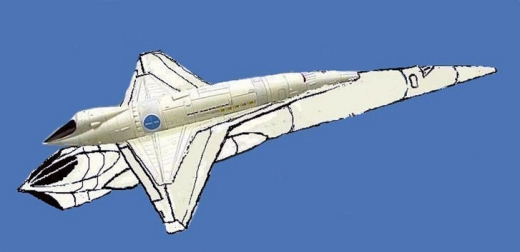
Image: Orion 1 and 3 mated for flight. Credit: Ian Walsh, who in addition to being a key player in designing and building the largest aperture telescope in the southwest of England is also a builder of scale models both factual and fictional.
This mid-60’s speculation for an ascent/entry transportation system is remarkably in line with (minus the rail sled) many of the European Space Agency’s extensive ’80s/’90s design studies of their Sänger II/Horus-3b shuttle [9]. (A multitude of TSTO studies in the Future European Space Transportation Investigations Programme [9] echoed the space transportation system suggested in the film 2001.) Perhaps Clarke’s prescience (and ESA’s design inspiration) stemmed not from looking forward but from looking back. Amazingly, basic physics had guided Eugen Sänger and Irene Brent—in 1938!—to define this fundamental configuration (including the rail sled) for their proposed ‘orbital space plane’ the Silbervogel.
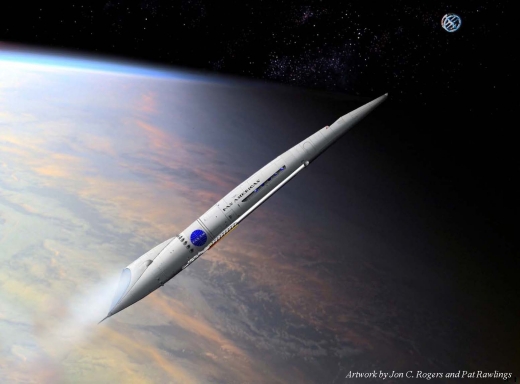
Image: The 2001 space plane going for orbit. Credit: Jon Rogers.
It is interesting that Arthur C. Clarke wrote a novel in 1947, Prelude to Space, with a horizontal take off two-stage-to-orbit spacecraft and twenty one years later it was depicted, though one has to read the novel to find this out. The second stage in Prelude to Space is nuclear powered while the Orion III is liquid oxygen-liquid hydrogen propulsion.
In recent times it was noticed that there was another shuttle to space station V, the Russian ‘Titov’, but it can only be seen inside an office on the station.
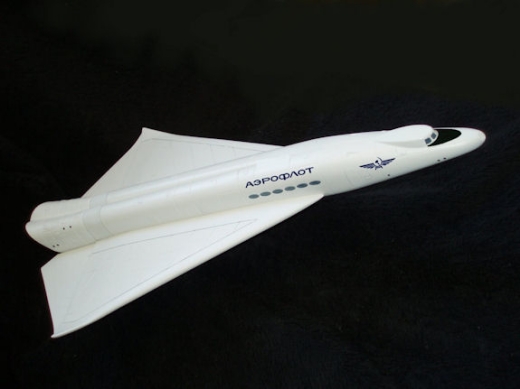
Image: Model of the Russian Titov shuttle, a tough catch unless you’re watching the movie extremely closely. Credit: Ian Walsh.
Zero G
One of the best aspects of 2001, and certainly a significant reason most knowledgeable space enthusiasts admire it, is its artistic use of true physics. Nearly every spaceflight scene shown in 2001 conforms to the way the real universe works. (And talk about a compliment to the special effects crew of the 1968 film — the Apollo 13 team achieved most of their zero-g effects by filming inside the NASA KC-135 training aircraft as it flew parabolic arcs.) 2001 has had a lasting influence on using facts in the story telling: in recent years, Gravity, Interstellar and The Martian used reality as a canvas.
If you are in an orbiting spacecraft that’s not undergoing continuous acceleration due to its own propulsion, you can’t just walk around like you’re heading into the kitchen from the living room. Those bastions of “science” fiction pop culture, Star Trek and Star Wars, conveniently used an old prose science fiction ploy, ‘super-science’ ‘field-effect’ gravity, to permit walking (due to F/X budgets or artistic license ). However, careful comparison of the 1968 film scenes to those of crew members operating in spacecraft today quickly reveals that Kubrick dealt with the technical (and potentially F/X-budget-busting) challenge of faking zero gravity by blending scientifically legitimate speculation, real physics on the soundstage, and a touch of artistic license that collectively helped to produce visually compelling aesthetics.
In 2001, when the crew move about in non-rotating parts of their spacecraft, they walk (and even climb up and down ladders) on Velcro (or some similar material) with special footwear. We first see this in the Orion III ‘shuttle’, when a stewardess walks in zero g using grip-shoes. In fact, one of the more visually interesting sequences (the stewardess heading up to the cockpit in the Aries IB moon shuttle) gains its impact with the idea — the stewardess calmly walks her way up a curving wall until she’s upside down. Station astronauts must fidget anxiously when they watch this scene since they would accomplish a similar trip today in seconds with just a few pushes. In today’s spacecraft, you don’t walk anywhere; you float.
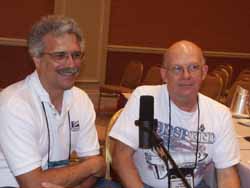
DCF 1.0
Image: Jon Rogers on the right, with Jack Hagerty, who along with Ian Walsh added comments and suggestions for this essay. Some background on Jon Rogers: An A.I.A.A. member for many years, Jon started his career as QA inspector on Apollo Hi-Gain antenna system, built microcircuits for the Space Shuttles, and was Sr. Mfg. Engineer on the GOES, INTELSAT-V, SCS1-4 Satellites. Mr. Rogers has written articles, co-authored/illustrated the Spaceship Handbook, and presented to the A.A.S. national convention, on the early history of spaceships. He received his degree from SJSU in 2000. Credit: Al Jackson.
Kubrick adopted the concept (not necessarily an unreasonable one for the mid-60s) that routine space flyers would insist on retaining the norms of earth operations, including walking, while in zero gravity. (In fact, most crewmembers do prefer at least a visual sense of a consistent up-and-down in spacecraft cabins.) While this helped him out of a major cinematic challenge, it predated the early 70’s Skylab program, when astronauts finally had enough room to really move around and learn the true freedom of zero gravity. You’ll note too that the flight attendant’s cushioned headgear also helped avoid the likely impossible task of cinematically creating freely floating long hair, a common sight in today’s downlink video.
2001 was probably the first space flight film to actually use zero g to depict zero g. In the scene where astronaut Dave Bowman re-enters the Discovery through the emergency hatch, the movie set was built vertically. This allowed actor Keir Dullea to be dropped, and thus undergo a second or two of freefall, before the wire harness arrested his plunge. (Note 5)
Of course, today’s space flyers use velcro to secure just about everything else. Cameras, checklists, pens, food containers — you can tell the space items apart from their earthbound cousins by their extensive strips of fuzzy tape. Unfortunately, this convenient fastener’s days in the space program may be numbered for long-duration flight. Velcro, composed of tiny plastic hooks, eventually wears out and small pieces break off and can become airborne hazards to equipment and crew. Consequently, long-stay crews keep equipment and themselves in place with other fastening techniques: Magnets, bungee cords, plastic clips, or even just simple foot straps.
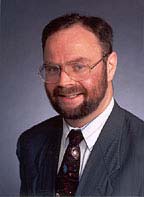
Image: Bob Mahoney. Passion for spaceflight propelled Bob Mahoney through bachelor’s and master’s degree programs in aerospace engineering at the University of Notre Dame and the University of Texas at Austin, respectively. Love of writing carried him into lead editorships of his high school’s literary magazine and Notre Dame Engineering’s Technical Review. Bob discovered an outlet for both of these passions while serving nearly ten years as a spaceflight instructor in the Mission Operations Directorate at Johnson Space Center. While working at JSC, he taught astronauts, flight controllers, and fellow instructors in the disciplines of orbital mechanics, computers, navigation, rendezvous, and proximity operations. His duties included development of simulation scripts for both crew-specific and mission control team training. Bob supported many missions, including STS 35, the first flight of Spacelab post-Challenger, and STS 71, the first shuttle docking to Mir. As Lead Rendezvous Instructor for STS 63, the first shuttle-Mir. rendezvous, and STS 80, the first dual free-flyer deploy-and-retrieve, he ensured both crew and flight control team preparedness in rendezvous and proximity operations.
Artificial Gravity
Kubrick and Clarke’s other method of fighting zero g was well-established in the literature of the time: centrifugal force. The physiological effects of zero g on humans had been a worry from the early days of theoretical thinking about spaceflight. Some thought it might be beneficial, but many worried that since the human body evolved in one g, long exposure to no or reduced gravity might be detrimental. In the film, both the large space station orbiting Earth and the habitation deck of the Jupiter mission’s Discovery spacecraft rotate to create artificial gravity for the inhabitants. While Gemini 11 achieved this during an experiment, the general trend in space operations has been to live with zero gravity (properly termed microgravity) while combating its effects on the human body through exercise. This path was chosen for two reasons: A rotating spacecraft’s structure must be significantly sturdier (and thus more massive, and thus more expensive to launch) to handle the stresses of spinning, and the utility of zero g seems to outweigh its negative aspects. Yet one must note that research on the ISS has indicated there are limits to how much exercise and other similar countermeasures can counteract physical deterioration. Living in zero g for extended periods of time, for interplanetary flight, now no longer seems possible. This is one aspect of space medicine research that makes the ISS such an important laboratory.
Ordway and Lange designed the Discovery‘s crew quarters centrifuge realistically to simulate/generate 0.3 g while counteracting Coriolis forces, but a 300-foot diameter wheel was just not feasible as a set. Nevertheless, Vicker’s aircraft built the fully working prop with remarkable accuracy. (6) The space station interior set did not rotate, but consisted of a fixed curved structure nearly 300 feet long and nearly 40 feet high. (2) The curve was gentle enough to permit the actors to walk smoothly down the sloping floor and maintain the desired illusion.
Food
A bit of a miss here, more dictated by the design of ‘space food’ in the 1960s than anything else. Whereas the Council of Astronautics’ Chief Heywood Floyd sips liquid peas and carrots through straws on the way to the Moon and the Jupiter-bound Discovery crew eats what could best be described as colored paste, today’s astronauts get to eat shrimp cocktail and Thanksgiving turkey dinners. Of course, these are either dehydrated or military-style MREs (Meals Ready to Eat), but they beat the zero-g mess problem simply by being sticky via sauce or gravy. The most accurate culinary prediction of Kubrick and Clarke was the lunar shuttle bus meal: sandwiches. However, when an ISS crewmember prepares that old staple peanut butter and jelly, he or she uses tortillas in place of bread. Like worn-out Velcro, bread makes too many crumbs, and crumbs can get into the electronics.
The galley on Discovery, however, has its counterpart on the Shuttle. While it didn’t automatically dole out an entire five-course meal based on crewmember selection (astronauts did this manually before liftoff back in Houston, and then their meals get packed in storage lockers), the shuttle galley did let them heat up items that are supposed to be hot and rehydrate that shrimp cocktail. The zero-gravity toilet instructions shown in the film, an intentional Kubrick joke, are much longer than the shuttle’s Waste Containment System crew checklist.
Propulsion
While the Orion III space plane’s external propulsion elements hint at systems a few years beyond even today’s state-of-the-art (possible air intakes for a scramjet and a sloping aerospike-like exhaust nozzle), the spherical Aries 1B moon shuttle has rocket nozzles which would look perfectly at home on the old lunar module. Kubrick was smart not to show exhaust as they fired, only lunar dust being blown off the lunar surface landing pad. Ordway has indicated that the propellants were LOX/LH2 and thus the exhaust would be extremely difficult to see in a vacuum in sunlight. Even the MMH/N2O4 shuttle jet firings washed out during orbital day.
One particular propulsion depiction potentially unique to 2001, which Kubrick likely used more for cinematic aesthetics as well for the sake of realism, is the roar, whine, or boom of engines in the space vacuum. Even Apollo 13 fell down here, going for the rock ‘n’ roll excitement of the service module’s jets pounding away with bangs and rumbles in external views. (Arguably Kubrick’s most inspired move ever was to overlay Johann Strauss’s ‘The Blue Danube’.) Something that almost all fictional space TV and movies miss is the cabin noise of those jets firing, however. Unlike the vacuum outside, a spacecraft’s structure can carry sound and the Shuttle crews do hear their jet firings; at least the ones up front near the cabin. They are quite loud — crewmembers have compared them to howitzers going off. (The 2013 film Gravity did use ‘interior’ sounds well, subtle enough that one does not catch it at first. Sounds transmitted through space suits and ship structures, and a clever use of the vacuum!)
2001‘s one big cinematic overshoot propulsion-wise is the nuclear rockets of the interplanetary Discovery. While deep-space probes such as Voyager, Galileo, and Cassini employ RTG units to generate electricity with the radioactive heat of their plutonium, no nuclear propulsion has ever flown in space to date, primarily because there has been no return to research on nuclear propulsion. (Note: The U.S. NERVA nuclear thermal rocket program was not canceled until 1972, a full four years after the movie’s release.)
The Discovery was powered by a gaseous fission reactor for rocket propulsion. The highest reactor core temperature in a nuclear rocket can be achieved by using gaseous fissionable material. In the gas-core rocket concept, radiant energy is transferred from a high-temperature fissioning plasma to a hydrogen propellant. In this concept, the propellant temperature can be significantly higher than the engine structural temperature.
Regarding the depiction of that nuclear propulsion in the film, Discovery was actually missing a major component: massive thermal radiators. As any nuclear engineer could point out (and described properly in the novel), these huge panels would have dominated the otherwise vertebrae-like Discovery‘s structure like giant butterfly wings. Even the decidedly non-nuclear fuel-cell-powered Shuttle and solar-cell-powered ISS sport sizable radiators to dump the heat of their electricity-powered hardware. Ordway and Lange were quite aware of the need for such radiators and appropriate models were built, but in the end aesthetics carried the day, so the cinematic Discovery coasted along (silently) somewhat sleeker than known physics demanded. (One interesting tidbit here: some Glenn Research Center engineers redesigned the Discovery recently as an engineering exercise.(10))

Image Credit: Jon Rogers.
Cabin Interior
Speaking of sound, 2001 may be the only fictional film to convey the significant background noise in a spacecraft cabin. Every interior scene in Discovery is colored with a background hum, most certainly meant to be the many spacecraft systems running continuously, including air circulation fans. Crews have reported that the Shuttle cabin is a very noisy workplace, and some portions of ISS were once rumored to merit earplugs.
As already noted, the Orion III cockpit is remarkably similar to the Shuttle cockpit. One notes that all of the cockpits in the film are “glass” cockpits, where all information is displayed on computer screens (versus the dials and meters typical of 1960s technology). But this time it was the real-world Shuttles that caught up with the film (and a significant portion of the world’s airliners). During the 1990s the orbiter’s cockpit displays (including many 1972-era dials and meters) were entirely replaced with glass-cockpit technology.
Hibernation
Nope. Still can’t do that today. Suspended animation is an old story device in prose science fiction, not seen as much these days. About the only progress there is therapeutic hypothermia which may be a step towards ‘hypersleep’.
In fact, the Salyut, Mir, and ISS programs were geared toward keeping crew members active for longer and longer durations, not asleep. The concept of conservation of crew supplies is reasonable enough, but even in 1968 multiyear missions did envision years-long expeditions with enough self-contained logistical support. The sleep stations shown on Discovery, however, appear to offer crewmembers the same small volume as those on the Shuttle or ISS.
Communications
This is a technology that really tends to hide behind the flashier and more obvious equipment but is so critical that it should never be taken for granted. Unfortunately, by using it as a device serving the subplot involving HAL and the Discovery crew, Kubrick and Clarke committed a serious misstep in predicting the technology of today — er, yesterday. If you recall, the first sign of HAL’s neurosis is his false report that the AE-35 unit (the electronic black box responsible for keeping Discovery‘s antennae suite pointed at Earth) is going to fail. Mission Commander Dave Bowman must take a spacewalk to haul it inside after replacing it with a substitute. After finding nothing wrong with it, the crew (acting on the ominous suggestion of the erroneous HAL computer) decides to put the original unit back.
Here’s the problem: a system as critical as the communications pointing system would not have a single-point failure, especially in a manned spacecraft flying all the way to Jupiter! In fact, a Shuttle launch was scrubbed because one of two communications black boxes was not working properly. The Shuttle was designed with fail-operational fail-safe redundancy. In other words, if a critical unit fails, the shuttle can still support mission operations. If a second, similar unit fails, the shuttle can get home safely. Realistically, such a failure in a sophisticated Jupiter-bound manned spacecraft would call for simple rerouting of the commands through a backup unit, with at least one more unit waiting in reserve beyond that. This wouldn’t be a very dramatic turn, but such a sequence would better parallel the occasional Shuttle and ISS systems failures that have thus far been irritating but not showstoppers. (Of course, not all those many years ago Mir lost all attitude control when its one computer failed, so perhaps the premise isn’t too far fetched…) Once again, though, this technical ‘glitch’ was dictated by the cinematic narrative. Is it not interesting, however, that our premier unmanned Jupiter probe, Galileo, suffered a crippling failure of its primary communications antenna?
On the spinning space station, Dr. Floyd makes an AT&T videophone call to his daughter. Today’s space station inhabitants do, in fact, converse with their families over a video link, but it’s reasonably certain that their calls don’t cost $1.70 and get charged to their calling cards.
Spacesuits & EVA
This is the issue wherein 2010, that bastard child, really makes “hard” science fiction fans hang their heads low. 2001 presented spacesuits (especially those on the Jupiter mission) that were sophisticated, logical in design, quite impressive in capability, and perfectly believable for an advanced space program. 2010‘s American spacesuits look like they rolled off the EMU rack at Johnson Space Center!
The single component of the 2001 suits worn by Dave Bowman and Frank Poole most analogous to the EMUs today is the built-in jet maneuvering pack. Small, unobtrusive, minimal — that pretty much sums up the SAFER unit developed for station EVA. The 2001 suit does reflect the modularity concept of the Shuttle-era suit as well: helmet and gloves attach to the main suit with ring seals, but Ordway and Lange did not anticipate the move towards “hard shell” design (the American suit’s rigid torso, the Russian back-door-entry Orlan). The cinematic suits appear much more akin to the old Mercury and Gemini configurations, or even the recent advanced design of Dr. Dava Newman at MIT. (Note 3)
One notes there is a glaring design failure in the Discovery EVA suits. There is an external oxygen hose from helmet to backpack. This does not exist in Harry Lange’s initial suit designs and that hose does not exist on Heywood Floyd’s suit and the other suits on the visit to the Lunar Monolith. It was a bit of cinematic drama that could have been taken care of with a suit tear, a rare oversight by Kubrick. Real space suits just don’t have a vulnerable oxygen supply tube from the backpack EMS unit to the suit helmet (we see Frank Poole fighting to reattach his). Even in 1965 Apollo space suits had much more secure fittings.
While not a matter of technical prognostication, we can’t help but mention that the EVAs shown in 2001 remain the most realistic fictional depiction of spacewalking ever put on film. (That is, until the 2013 film Gravity.) The fluidity of motion and the free-floating grace of the crewmembers as they move completely in line with real physical laws is nearly identical to what you see downlinked on NASA TV. Not impressed? Compare Bowman’s approach and arrival at the Discovery‘s antenna in 2001. How’d Kubrick pull it off? Skilled stuntmen suspended from cables filmed from below—that was the key. Filming at high speed and then slowing the footage for incorporation in the film also helped. (In Apollo 13 extensive use was made of flying parabolic arcs in a Boeing KC-135 — that was real zero g. Alfonso Cuarón used ‘motion capture’ and computer generated imagery in Gravity.
One EVA item in 2001 that today’s engineers and astronauts would love to have but don’t is the space pod: that ball of a spacecraft with the pair of multi-jointed arms out front. Such a vehicle would eliminate the need for some suited EVAs (the crewmember could just stay inside the pod) and would make others much easier (since the pod, under the control of the ship’s highly intelligent computer, could help out). But if you think about it, we’re really not too far off with the Shuttle and ISS remote manipulator systems (the Canadarms) These now (especially with the recent addition of DEXTRE with its two multi-jointed arms) permit the accomplishment of some tasks outside the spacecraft without EVA, and they have proven themselves capable EVA assistants under the control of a highly intelligent computer—namely, a crew member back inside the spacecraft cabin!
The most glaring difference in EVA, however, lies in protocol. During the EVAs in 2001, a single crewmember conducts the EVA. This is just not done today. Both Americans and Russians always leave their spacecraft in pairs (and in rare circumstances, as a trio) for safety’s sake — if one crewmember gets in trouble the other can come immediately to their aid. However, practically speaking, both crew members did have a companion: HAL the computer, controlling the space pod. But, of course, the solo EVA, the single-point communications failure necessitating the EVA, and HAL’s control of the space pod, collectively set up the greatest drama in the film: HAL trying to kill off all his crewmates.

Image Credit: Jon Rogers.
Artificial Intelligence
Given the many different levels at which the space program (and society as a whole) use computers today, it is within this niche that the film’s accuracy is most difficult to gauge.
Certainly, we have computers that can talk, and Shuttle and station crews have experimented with voice-activated controls of some systems, but these are superficial similarities. More importantly, we find a better comparison in the command and control realm: during large portions of a Shuttle’s mission, the fail-operational fail-safe primary & backup computer suite of five GPC computers did control the vehicle just as HAL completely controlled Discovery. (In fact, as a particularly curious side note, the programming language for the Shuttle’s primary computers is actually termed HAL/S, for Higher Assembler Language/Shuttle, but this just might be a not-so-subtle homage to the film by the software development team.) Unlike a lot of prose science fiction, 2001 did anticipate flat screen TVs and what seem to be IPADs!
The film was created at a point in history when the computer’s invasion of our society (including spaceflight) might have taken one of two paths: bigger and more powerful mainframe computers that would interface everywhere through an extensive but centrally controlled communications network, OR smaller and smaller special-purpose computers that each would do a little bit of the work. HAL certainly represents the pinnacle of achievement for the former — an artificial intelligence that had control of every single aspect of the Discovery‘s operations. The distributed PC network controlling the ISS today reflects the latter.
Yet the depiction of the HAL 9000 (Heuristically programmed Algorithmic Computer) in 2001 remains one of the film’s most eerie elements. For their description of artificial intelligence, Kubrick and Clarke only had the terminology and the vision of the mid-1960’s as their guide. At that time the prevailing concept expected ‘AI’ to be a programmed computer. Thus the term ‘computer’, with all its implications of being a machine, occurs repeatedly.
But in the last 50 years no true ‘strong’ AI has emerged. Today’s corresponding term would be ‘strong AI’ (11); their use of mid-1960’s terminology obscures the fact that Kubrick constructed an AI that is unmistakably ‘strong’, that is, capable of “general intelligent action.” How this would have been achieved Kubrick and Clarke left to the imagination of the viewer and the reader.
As HAL seems to be a ‘strong AI’, capable of feeling, independent thought, emotions, and almost all attributes of human intelligence, anyone viewing the film today should forget the film’s and novel’s use of the terms ‘computer ‘and ‘programming’. HAL seemed able to reason, use strategy, solve puzzles, make judgments understand uncertainty, represent knowledge including common-sense knowledge, plan, learn, communicate in natural language, perceive and especially see, have social intelligence, be able to move and manipulate objects (robotics), and integrate all these skills toward common goals. These attributes are possible not through programming as much as through ‘evolving’ or ‘growing-learning’ … a ‘solid-state intelligence’. That is why it is amazing to watch the film today (despite its use of clunky, ill-suited words like computer and program) and realize that HAL was a TRUE AI. HAL likely will exist in a universe which we have yet to realize, but one has no idea when! (See note 4.)
Some Reverse Engineering
From the moment we meet HAL we are given to believe that this particular AI has total control of everything in the Discovery. He can take action — open pod doors, open pod bay doors, even adjust couch cushions! — at a crewmember’s spoken word. Yet after HAL kills Frank Poole and the hibernating crewmembers followed by Dave Bowman’s return to the Discovery, what do we see? A manual, emergency airlock/entrance.
What is that doing there? Directly, to provide the film with an ‘action scene’, but the implications are deeper. Ordway/Lange of the Discovery knew their spaceships! A ship that substantial on an important mission must have redundancy; if not in the communications system, then at least to back up the onboard AI! Ordway wrote a memo to Kubrick about ship redundancy (7a). What if HAL had been ‘holed’ by a very freak meteor hit? What if an ultra-high-energy cosmic ray bored a damaging track through one of HAL’s solid state modules? Any of a number of possible unpredictable second- and third-order failures might occur, so the crew might be forced to take care of the ship and mission ‘on their own.’
And it is here, in the consideration of backup systems, where we catch Kubrick and Clarke, the storytellers, at odds with Kubrick and Clarke, the prognosticators of realistic spacecraft design. We find Bowman and Poole discussing how to partially shut HAL down by leaving only primitive functions operating. That could only be an option if the human crew could control the Discovery manually (or rather more practically, semi-manually) with a lot of help from still-working automated systems. This issue is more explicit in the movie and implicit in the film.
In fact Kubrick mildly trumps Clarke technically and dramatically in the film’s narrative structure (wherein Bowman leaves the ship to rescue Poole, setting up the emergency airlock action scene). In the novel, Clarke merely has HAL ‘blow down’ the Discovery by opening the pod bay doors. However, examining Lange and Ordway’s drawings of the Discovery‘s living quarters reveals at least two airlocks between the pod bay and the centrifuge (7,7a,8,9). Independent double and triple overrides (over which HAL had no control) would have come into play to prevent this very scenario from happening, mechanically or insane-AI-instigated.
How about HAL’s control of Dave’s pod? Actually one can capture a frame in the pod (‘N/A HAL COMLK’) that shows that Bowman, even though he left his helmet behind, had the sense to cut HAL’s control of the pod. It is impressive but not surprising that Kubrick and his team thought to include such a detail.
When Comes the Future?
While Kubrick and Clarke’s iconic 1968 vision of spaceflight’s future may have been far off the mark in terms of how much we would have accomplished by the turn of the millennium, its accurate anticipation of so many operational and technological details remains a fitting testament to the engineering talent of their supporting players, especially Fred Ordway and Harry Lange. The astounding prescience in their projections of the specifics of space operations decades beyond the then-current real spaceflight of Gemini and Apollo, even when constrained by storytelling aesthetics, offers the promise that their spectacular rendering of a spacefaring society may still come to pass.
With the United States and other nations now finally developing systems to return human crews to the Moon and enable travel beyond, and with commercial entities actively pursuing private spaceflight across a spectrum of opportunities long considered a matter of fantasy, perhaps we can take heart in the possibility that by the time another fifty years have passed, Kubrick and Clarke’s brilliant, expansive, and yet convincingly authentic future may finally become real in both its details and its scope.
Selected Bibliography
(1) 2001: A Space Odyssey, by Arthur C. Clarke, based on a screenplay by Stanley Kubrick and Arthur C. Clarke. Copyright 1968. The New American Library, Inc.
(2) The Making of Kubrick’s 2001, edited by Jerome Agel. Copyright 1970 The Agel Publishing Company, Inc. The New American Library, Inc.
(3) 2001: filming the future, by Piers Bizony. Copyright 1994. Aurum Press Limited.
(4) The Lost Worlds of 2001, by Arthur C. Clarke. Copyright 1972. The New American Library, Inc.
(5) The Odyssey File, by Arthur C. Clarke and Peter Hyams. Copyright 1984. Ballantine Books.
(6) “2001: A Space Odyssey,” F.I. Ordway, Spaceflight, Vol. 12, No. 3, Mar. 1970, pp. 110-117. (Publisher: The British Interplanetary Society).
(7) Part B: 2001: A Space Odyssey in Retrospect, Frederick I Ordway, III Volume 5, and American Astronautical Society History Series, Science Fiction and Space Futures: Past and Present, F.I. Ordway, Edited by Eugene M. Emme, 1982, pages 47 – 105. (ISBN 0-87703-173-8).
(7a) Johnson, Adam (2012). 2001 The Lost Science. Burlington Canada: Apogee Prime
(7b) Johnson, Adam (2016). 2001 The Lost Science Volume 2. Burlington Canada: Apogee Prime.
(8) Jack Hagerty and Jon C. Rogers, Spaceship Handbook: Rocket and Spacecraft Designs of the 20th Century, ARA Press, Published 2001, pages 322-351, ISBN 097076040X.
(9) Dieter Jacob, G Sachs, Siegfried Wagner, Basic Research and Technologies for Two-Stage-to-Orbit Vehicles: Final Report of the Collaborative Research Centres 253, 255 and 259 (Sonderforschungsberiche der Deutschen Forschung) Publisher: Wiley-VCH (August 19, 2005).
(9) Realizing 2001: A Space Odyssey: Piloted Spherical Torus Nuclear Fusion Propulsion NASA/TM-2005-213559 March 2005 AIAA-2001-3805.
(10) Searle, J. (1997). The Mystery of Consciousness. New York, New York Review Press.
(11) The film 2001: A Space Odyssey, premiere date April 6 1968.
Notes
(1) Acknowledgments: Thanks to Ian Walsh, Jack Hagerty and Wes Kelly , personal communications. Also, Special thanks to Douglas Yazell and the Houston section of the American Institute of Aeronautics and Astronautics for hosting the first edition of this article in 2008.
(2) In the mid 1960’s many of the SETI pioneers were afraid that revelation of the existence of an advanced extraterrestrial civilization might cause a social disruption; many others disagreed with this. Kubrick and Clarke decided to keep this as a plot device.
(3) There is an amusing bit of homage to George Pal in the film. In the 1950 movie the commander’s suit is red, the 2nd in command has a yellow one, all the rest are blue. Same is true in 2001! [8]
(4) The novel 2010 explains HAL’s ‘insanity’ in terms of his keeping the discovery of the TMA-1 monolith a secret for reasons of national security. (note 2) (Whatever that means.) This contradiction against his programming to never report erroneous information created a “Hofstadter-Moebius loop,” which reduced HAL to paranoia. Since nothing explicit is presented in the original film, and taking the characterization of HAL as a strong AI (for all intents and purposes making him ‘human’), HAL could have just as well gone bonkers for no good reason at all!
(5) A technical point about the emergency entry into the Discovery. Where did the pod hatch go? One notes that the pod doors slide ‘transversely’, i.e., they don’t swing in or out. In the airlock entrance scene Dave launches himself from ‘frame right’; normally the pod door slides open toward frame right (we’re seeing the rear of the pod in the scene). Thus the door’s guide track ran on both sides of the pod’s hatchway. Thus the normal open/close mechanism wouldn’t have to be retracted out of the way in an emergency. The pyros would be on the attach points where the door joins the mechanism, and in an emergency they’d blow the door further around the track, i.e., ‘frame left’, out of the way, while the regular mechanism stays put. (Thanks to Jack Hagerty for this observation.)
(6) 2018 is also the 30th anniversary of the viable ‘traversable wormhole’ by Morris and Thorne, this gives the ‘Star Gate’ in 2001 some physics which it did not have in 1968. M. S. Morris and K. S. Thorne, “Wormholes in spacetime and their use for interstellar travel: A tool for teaching General Relativity”, Am. J. Phys. 56, 395 (1988).

Imaging a Centauri Planet
Last December I mentioned the ongoing work at the European Southern Observatory’s Very Large Telescope to modify an instrument called VISIR (VLT Imager and Spectrometer for the InfraRed). Breakthrough Initiatives, through its Breakthrough Watch program, is working with the ESO’s NEAR program (New Earths in the Alpha cen Region) to improve the instrument’s contrast and sensitivity, the goal being the detection of a habitable zone planet at Alpha Centauri. Exciting stuff indeed, especially given the magnitude of the challenge.
After all, we are dealing with a tight binary, with the two stars closing to within 11 AU in their 79.9 year orbit about a common center (think of a K-class star at about Saturn’s distance). The binary’s orbital eccentricity can separate the stars by about 35 AU at their most distant. The latest figure I’ve seen for the distance between Centauri A/B and Proxima Centauri is about 13,000 AU.
In an ESO blog post that Centauri Dreams reader Harry Ray passed along, planet hunter Markus Kasper explained that the performance goal for the upgraded VISIR requires one part in a million contrast at less than one arcsecond separation, something that has not yet been demonstrated in the thermal infrared. Alpha Centauri A/B will be a tough nut to crack. Kasper makes a familiar comparison: This is like detecting a firefly sitting on a lighthouse lamp from a few hundred kilometres away.
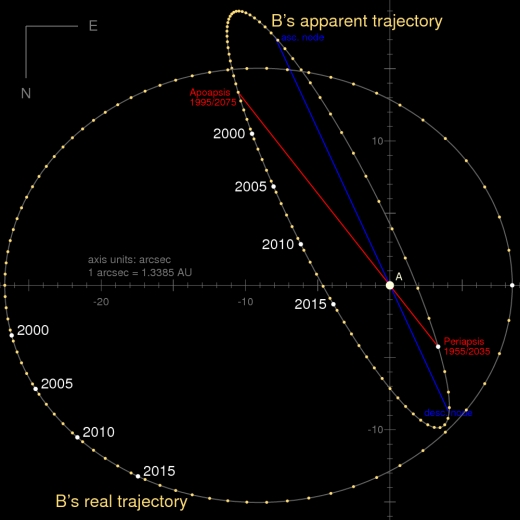
Image: Apparent and true orbits of Alpha Centauri. The A component is held stationary and the relative orbital motion of the B component is shown. The apparent orbit (thin ellipse) is the shape of the orbit as seen by an observer on Earth. The true orbit is the shape of the orbit viewed perpendicular to the plane of the orbital motion. According to the radial velocity vs. time [12] the radial separation of A and B along the line of sight had reached a maximum in 2007 with B being behind A. The orbit is divided here into 80 points, each step refers to a timestep of approx. 0.99888 years or 364.84 days. Credit: Wikimedia Commons.
But VISIR may be up to the task. Installed at Paranal, 2635 metres above sea level in Chile’s Atacama Desert in 2004, it has been used to probe dust clouds at infrared wavelengths to study the evolution of stars. The instrument is capable of compiling in a scant 20 minutes as many images or spectra as a 3-4 meter telescope could obtain in an entire night of observations. VISIR has also been used to study Jupiter’s Great Red Spot, Neptune’s poles, and the supermassive black holes that can occur at the centers of galaxies.
Ramping up VISIR’s capabilities for Alpha Centauri is a multi-part effort, as Kasper describes:
Firstly, Adaptive Optics (AO) will be used to improve the point source sensitivity of VISIR. The AO will be implemented by ESO, building on the newly-available deformable secondary mirror at the VLT’s Unit Telescope 4 (UT4).
Secondly, a team led by the University of Liège (Belgium), Uppsala University (Sweden) and Caltech (USA) will develop a novel vortex coronagraph to provide a very high imaging contrast at small angular separations. This is necessary because even when we look at a star system in the mid-infrared, the star itself is still millions of times brighter than the planets we want to detect, so we need a dedicated technique to reduce the star’s light. A coronagraph can achieve this.
Finally, a module containing the wavefront sensor and a new internal chopping device for detector calibration will be built by our contractor Kampf Telescope Optics in Munich.
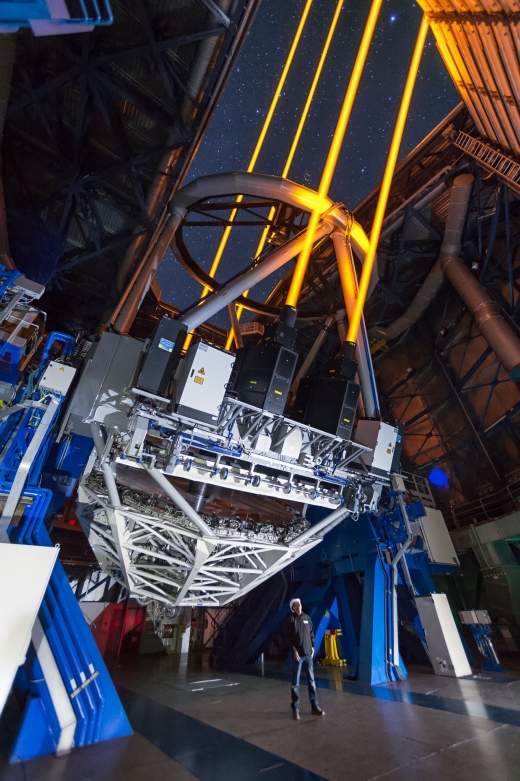
Image: Adaptive optics at work. Glistening against the backdrop of the night sky about ESO’s Paranal Observatory, four laser beams project out into the darkness from Unit Telescope 4 (UT4) of the VLT. Some 90 kilometres up in the atmosphere, the lasers excite atoms of sodium, creating artificial stars for the telescope’s adaptive optics systems. Credit: ESO/F. Kamphues.
The exciting prospect, says Kasper, is that a habitable zone planet could be detected in just 100 hours of observing time on the VLT. To do this will first entail moving VISIR from Unit Telescope 3 to Unit Telescope 4 at Paranal. Hardware testing in Europe continues and the upgrade is expected to be implemented in VISIR by the end of 2018, with the Alpha Centauri observing campaign scheduled for mid-2019, a two-week run that will collect the needed 100 hours of observing time. We may not be far, then, from a planet detection at Centauri A/B.
Kasper points to Breakthrough Initiatives as key players in all this. Let me quote him:
…it is exciting to see how the Breakthrough Initiatives are managing to create momentum in the research field. By backing ideas and projects with a higher risk level than public funding agencies are ready to support, the Initiatives have motivated scientists to push the envelope and leap forward in their research.
Remember that Breakthrough Starshot not only achieved a great deal of media coverage but also caught the eye of a US congressman, with its goal to design and fly tiny probes by beamed sail to the Alpha Centauri system. NASA has begun to look at interstellar concepts again, a small but welcome effort long after the closing of the Breakthrough Propulsion Physics program. Breakthrough Listen is actively conducting SETI at Green Bank and Parkes in Australia. Breakthrough Watch now looks for habitable zone planets within 16 light years of Earth.
Pushing projects with higher risk levels is something that a private initiative can achieve, with repercussions for the broader effort to characterize nearby planetary systems and some day reach them with a probe. We’ll soon have the tools in place to study planetary atmospheres around many of these stars, so the timing of the VISIR effort could not have been better.

ARIEL: Focus on Exoplanet Atmospheres
Given Centauri Dreams‘s interest in exoplanet studies, it’s no surprise that when I write about the James Webb Space Telescope, it’s usually to fit the observatory into the overall study of other stellar systems. But of course JWST has been conceived to study everything from the earliest stars and galaxies to the ongoing birth of stars out of massive clouds of dust, not to mention objects within our own Solar System. JWST also offers us a real chance to probe exoplanet atmospheres around nearby M-dwarfs, but it is certainly not a dedicated exoplanet mission.
So while we hope for a successful launch in 2020, according to the evolving schedule, and look forward to finding plenty of JWST targets with the upcoming Transiting Exoplanet Survey Satellite (TESS), let’s have a look at a new mission from the European Space Agency with a tight exoplanet focus. The Atmospheric Remote-sensing Infrared Exoplanet Large-survey (ARIEL) has just been selected as an ESA science mission scheduled for launch in 2028. Its reason for existence is to look at how planetary systems form and evolve.
Giovanna Tinetti (University College London) is principal investigator here, which bodes well — I am a great admirer of Dr. Tinetti’s work and see ARIEL as being in excellent hands. Of the mission, Tinetti says this:
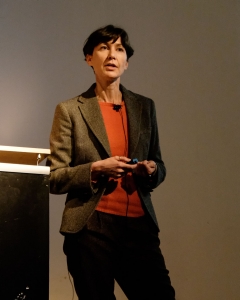
“Although we’ve now discovered around 3800 planets orbiting other stars, the nature of these exoplanets remains largely mysterious. ARIEL will study a statistically large sample of exoplanets to give us a truly representative picture of what these planets are like. This will enable us to answer questions about how the chemistry of a planet links to the environment in which it forms, and how its birth and evolution are affected by its parent star.”
Image: Giovanna Tinetti during a lecture at the Flamsteed Astronomy Society. Credit: Andy Sawers.
ARIEL’s targets are to be exoplanets from Jupiter-mass down to super-Earths, with the primary focus on planets in warm and hot orbits close to their parent star. The thinking here is that high temperatures keep different molecular species in circulation throughout the atmosphere, making them more easily detected because they do not as readily sink or form cloud layers that can obscure them. In that sense, a planet at 2000 degrees Celsius becomes a useful laboratory, churning with interesting molecules from the atmosphere and even from the planet’s interior.
Current plans call for a launch from Kourou in French Guiana into an orbit around the L2 Lagrange Point 1.5 million kilometers from Earth, where the Webb instrument is also headed. Here the balance of gravitational forces keeps the spacecraft in a fixed position relative to the Earth and Sun with a minimal expenditure of energy. Both spacecraft will essentially be ‘parked’ at the same region in space, unlike the Spitzer instrument, which is in orbit around the Sun and will eventually lose communications when its orbital path takes it behind Sol.
While JWST will view the universe in infrared, ARIEL’s meter-class primary mirror will also collect visible light, using a spectrometer to study planetary atmospheres through transmission spectroscopy, possible when a planet passes in front of or behind its star. One of its sensors will be capable of detecting the presence of clouds. Tinetti and team hope to observe 1,000 exoplanets, following up on the worlds discovered by upcoming missions like TESS, and paving the way for future European missions like CHEOPS and PLATO. A successful JWST launch will likewise result in new target options for ARIEL. The 1,300 kg spacecraft has a cost cap of 450 million euros, roughly $550 million at current rates.
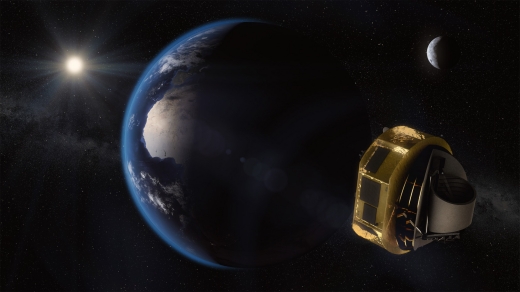
Image: Artist’s impression of ARIEL on its way to Lagrange Point 2 (L2). Here, the spacecraft is shielded from the Sun and has a clear view of the whole sky. Credit: ESA/STFC RAL Space/UCL/Europlanet-Science Office.
You may have heard about an exoplanet mission called EChO (Exoplanet Characterization Observatory), which was a candidate for ESA’s Cosmic Vision program. ESA did not fund the mission, which led Tinetti and colleagues to design the similar ARIEL observatory around a spacecraft with a lighter, less complex payload. The PLATO mission that supplanted EChO as one of ESA’s medium-class missions is an exoplanet observatory slated for a 2026 launch.

Getting JWST Aloft
No one said this was going to be easy. Delays involving the James Webb Space Telescope are frustrating, with NASA now talking about a launch in mid-2020 instead of next year, and the uncertain prospect of a great deal of further testing and new expenditures that could run the project over budget, necessitating further congressional approval. It’s hard to look back at the original Webb projections without wincing. When first proposed, estimates on the space observatory ran up to $3.5 billion, a hefty price tag indeed, though the science payoff looked to be immense. It was in 2011 that a figure of $8 billion emerged; the project now has a Congressionally-mandated cost cap of $8.8 billion.
And now, looking forward, we have Thomas Zurbuchen, speaking for NASA’s Science Mission Directorate, explicitly saying “We don’t really fully know what the exact cost will be…”
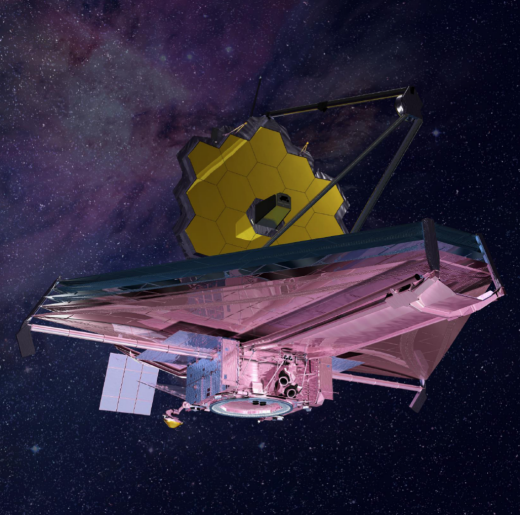
Image: Illustration of NASA’s James Webb Space Telescope. Credit: NASA.
Projects this big invariably take us into the realm of acronyms, with the project’s Standing Review Board (SRB) concluding that further time is necessary to integrate the various components of JWST. But we also learn that NASA is setting up an Independent Review Board (IRB) to complement the SRB findings. The space agency will look at the findings from both boards and consider their recommendations by way of taking us to a more specific launch schedule, with an assessment due in a report to Congress this summer. This NASA news release also talks about “Additional steps to address project challenges include increasing NASA engineering oversight, personnel changes, and new management reporting structures.”
There’s no question about the challenges JWST presents. Its spacecraft element is made up of the huge sunshield (the size of a tennis court), along with the spacecraft bus including the flight avionics, power system and solar panels. The collapsible sun shield must be folded and re-folded during the test process. Eventually it must be mated with the 6.5 meter telescope and science payload. The latter were successfully tested in 2017 at Johnson Space Center, with the telescope element being delivered to Northrop Grumman earlier this year.
Both halves of the observatory are now in the same facility for the first time. Ahead for the spacecraft element is vibrational, acoustic and thermal testing, necessary before the observatory can be fully integrated and pronounced ready for flight. The area of concern is the sun shield and bus, both developed by Northrop Grumman. Contributing to the delay, according to this Lee Billings essay, is a series of tears that appeared on the shield while being tested for deployment. The shield is said to have created a snagging hazard, forcing the addition of springs to prevent it from sagging. Other errors have involved the spacecraft thrusters.
What to do? Northrop Grumman teams are now working on the telescope 24 hours a day, while NASA is calling in the cavalry, as Marina Koren describes in The Atlantic:
Nasa announced some measures they would take at Northrop Grumman’s facility in California, where all of Webb’s parts currently reside. The space agency said they will increase engineering oversight at the facility in Redondo Beach and will track the company’s test reports on a weekly basis. Senior management from nasa’s Goddard Space Flight Center in Maryland, where much of the telescope was constructed, will work out of Northrop Grumman’s offices on a permanent basis. Northrop Grumman’s project manager for Webb will report directly to C-suite level executives at the company “to help remove roadblocks to success within the company,” the officials said.
Northrop Grumman is the prime contractor for JWST, but it appears that deeper NASA involvement in the process is forced by events. Ahead for the observatory is the tough environmental testing of sun shield and bus that the telescope and science instruments have already received. This in itself is a matter of several months, after which JWST can be assembled and tested in final form. The feeling at this end is that JWST has become so expensive, so pivotal in our astronomical roadmap, that it is too big and too expensive to fail.
That means its launch and deployment are going to be fraught with tension. 100 times more powerful than Hubble, JWST will operate 1.5 million kilometers from Earth, meaning that servicing missions by astronauts like Hubble has received will not happen. What would the path forward be if we lost JWST because the complex deployment process failed?
Also worth pondering: What will be the effect of any JWST overspending on the WFIRST mission? The Wide Field Infrared Survey Telescope has had its funding restored and operations continue, but we can’t rule out future attempts to cut the budget or even derail the program entirely. In the realm of technology, WFIRST may prove the easier of the two missions to complete, as this story in Nature points out:
JWST and WFIRST are very different technologically, says Jon Morse, chief executive of Boldly Go Institute, a space-exploration organization in New York City, and former head of NASA’s astrophysics division. JWST involves complex designs that have never been tested before, such as the enormous sunshield. WFIRST will use a well-understood 2.4-metre mirror design that does not require lots of new technology.
“WFIRST is not likely to develop the cost problems of the same magnitude as JWST,” Morse says.
Assuming its operations budget isn’t too severely raided to pay for JWST’s extra costs. By comparison, WFIRST’s own budget cap is a relatively svelte $3.2 billion.

